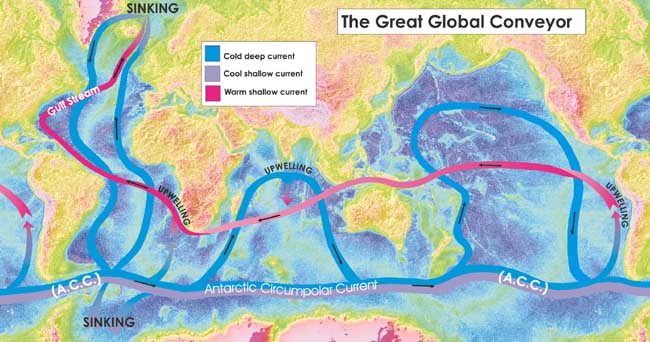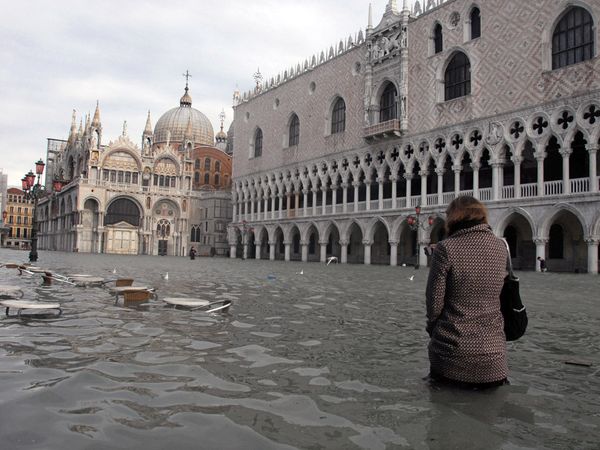Our oceans today are experiencing the highest mean temperatures ever recorded, up 0.59 degrees Celsius (1.1 Fahrenheit) since we started keeping records. True we have only been doing this since the 19th century, but during that period the warming appears to be consistent with higher increases in polar ocean regions. It is also apparent that the warming ocean is not just a surface phenomena but is happening in parts of the deep ocean as well. The rising temperatures in the atmosphere correlate with those rises we see in our oceans.
What does a warming ocean mean for life in the sea and on land? How does a warming ocean affect weather and climate? Should we be concerned? And if so have we got anything in our technical bag of tricks that we can deploy to stabilize the temperature rise or reverse it?
The Ocean Heat Engine and How it Works
Our atmosphere and ocean together can be described as a heat engine absorbing energy from sunlight which then gets converted to heat. The ocean is further subjected to gravitational forces caused by the pull of the Sun and Moon contributing to tides. The atmosphere and ocean share heat although the ocean is a much better heat absorber because it is more dense.
Other contributors to ocean heat include geothermal activity on the ocean floor along the edges of continental plates or over hot spots in the Earth’s crust. The level of salt in ocean water can impact its temperature. Fresh water tends to have a lower heat capacity than salt water. That’s why fresh water freezes at 0 degrees Celsius (32 Fahrenheit) while ocean water freezes at -1.9 degrees Celsius (28.58 Fahrenheit).
Like the atmosphere the ocean is layered, most dense at the bottom and least at the top. Unlike the atmosphere which is warmest at its bottom, the deepest parts of the ocean are the coldest.
Now add the Earth’s orbital tilt, and the consequential uneven distribution of sunlight falling on ocean surfaces from the poles to the equator. Then start the globe spinning and you have set the ocean and atmospheric heat engine in motion. Net heat gained in the equatorial regions is absorbed by surface ocean water, part of which evaporates into the atmosphere. Water vapour in the atmosphere increases its heat capacity leading to an exchange of heat between lower and higher elevations. The spinning earth contributes to wind movement. Winds contribute to ocean surface movement. Warm ocean water starts to move forming the currents we know as the Gulf Stream, the Kuroshio and the North Atlantic Drift. The extra heat moves poleward and counter currents of cold water and air move towards the equator, displaced by the warmer ocean water which is saltier and more dense as water evaporates from it into the atmosphere. Scientists call this movement of warm ocean water the thermohaline circulation.

Five Implications of a Warming Ocean?
1. Changes to marine life
Warmer ocean water should change the distribution of phytoplankton (tiny plants) in the ocean and as a result the growth of zoo-plankton (tiny animals). This means more krill (the tiny shrimp zoo-plankton) for baleen whales and fish. So isn’t this a good thing? Research has shown that initially added warmth causes a surge in marine organisms, particularly phytoplankton followed by zoo-plankton. But the latter soon consumes so much of the former that biomass crashes and shrinks by as much as 50%.
2. Changes to the polar seas
Today our polar oceans are among the most diverse marine life environments on the planet. That’s because of the upwelling of cold water from the ocean deep containing nutrient-rich food sources for the phytoplankton to thrive and grow. As the oceans warm we may witness a change in the mix of warm and cold water at the poles. The diminishing of sea ice may reduce fish stocks rather than enhance them.
3. Changes to the absorptive capacity of the ocean
A warmer ocean has the capacity to absorb more of the air that lies above it. That means more dissolved CO2. And more dissolved CO2 means more acidic oceans. And more acidic oceans means those creatures that use calcium carbonate become more vulnerable. For coral, zoo-plankton, mollusks and others it can mean extinction. Corals build coral reefs, zones of rich biodiversity in our oceans. We lose the reefs – we lose a lot.
4. Rising sea levels
When water heats it expands. It’s that simple. So a warmer ocean even without melting polar ice caps and glaciers is going to be higher. In fact scientists attribute half of the rise in sea levels to warming ocean water.
Now add the melt water from sea ice as the polar oceans heat up, or the melt from glaciers in Greenland, or the Antarctic ice sheets and shelves and you can begin to see just how significant the threat can be. The picture of Venice, Italy says it all. Our coastlines and coastal cities like Venice will be under siege from a steadily warming ocean. Add storm surges to this scenario and imagine the potential for disaster.

5. Changes to weather
A warming ocean impacts weather globally. We have seen the impact of warm ocean water through events we call “El Nino” that occur in the eastern Pacific Ocean in a cyclical manner. These periodic changes create global weather havoc affecting rainfall, temperatures and agricultural production.
A warming ocean impacts the natural cyclonic weather patterns, particularly those we call hurricanes and typhoons. These tropical storms form over warm water. Hurricane prediction models that simulate how hurricanes form and track suggest a correlation between sea surface temperatures and the storms that end up becoming the strongest.
What Can We Do About It?
Warming oceans are part of a general warming of the planet that today we describe as global warming. So to tackle warming oceans we have to deal with the root causes of the global warming phenomenon.
We have three choices:
1. Mitigation
Reducing CO2 and other greenhouse gas emissions should reduce the amount of change we experience on the planet and hence in our oceans. This requires a commitment from all of humanity through international agreement to act. Carbon sequestration, greenhouse gas reductions, cap and trade implementation, new energy technologies, conservation – these are all policies which our governments need to legislate and enforce. The cost is high but mitigation as a choice will cost far less than adaptation or the third option listed below.
2. Adaptation
Engineer infrastructure and come up with technological solutions to combat the consequences of warming oceans. We can seed the oceans with lime to reduce CO2 absorption precipitating the formation of limestone on the sea floor. We can build dikes, berms and higher sea walls to protect coastlines and coastal cities from rising sea levels. We can move threatened populations away from Pacific and Indian Islands, or from delta regions along coastlines that will be inundated by a warming ocean. We can strengthen our buildings to withstand more frequent and more violent storms. We can adapt crops to changing precipitation and weather patterns. We can deploy satellites in space that deflect sunlight or we fiddle with the atmosphere to create more clouds and cool down the planet artificially. The cost of geo-engineering will be enormous. Any mistakes we make could lead to the deaths of millions of humans let alone other life on the planet.
3. Do Nothing
This is always an option. We gamble that ocean warming is cyclical and that atmospheric warming in the last century is an aberration and not a consequence of greenhouse gas emissions. We react when disaster occurs suddenly or creeps up on us over time and we choose to ignore or think about the root causes.








